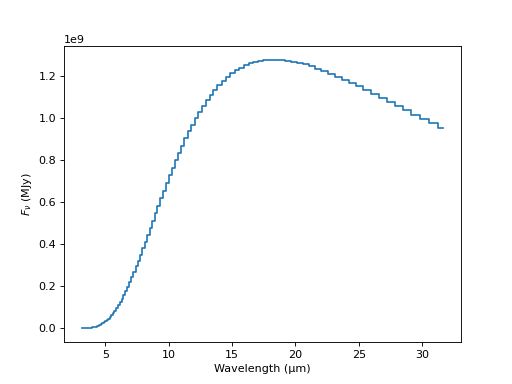Spectroscopy Sources Module (sbpy.spectroscopy.sources)¶
sbpy uses the sources module for evaluation and
binning of spectra and spectral models.
Blackbody spectra¶
The BlackbodySource encapsulates a
blackbody spectral model. It represents the spectral flux density
from a sphere, i.e., πB(T), where B is the Planck function.
Initialize from temperature:
>>> import astropy.units as u
>>> from sbpy.spectroscopy.sources import BlackbodySource
>>>
>>> B = BlackbodySource(T=278 * u.K)
>>> print(B)
<BlackbodySource: T=278.0 K>
Observe the source through a fictitious 10-μm filter:
>>> from synphot import SpectralElement, Box1D
>>> N = SpectralElement(Box1D, x_0=10.5 * u.um, width=1 * u.um)
>>> print(B.observe(N, unit='MJy'))
783577717.2783749 MJy
Observe the source through a low-resolution spectrometer:
import numpy as np
import matplotlib.pyplot as plt
import astropy.units as u
from sbpy.spectroscopy.sources import BlackbodySource
B = BlackbodySource(T=278 * u.K)
wave = np.logspace(0.5, 1.5, 100) * u.um
fluxd = B.observe(wave, unit='MJy')
plt.plot(wave, fluxd, drawstyle='steps-mid', label=str(B.T))
plt.setp(plt.gca(), xlabel='Wavelength (μm)', ylabel='$F_ν$ (MJy)')
(Source code, png, hires.png, pdf)

Developers’ Notes¶
Developers wanting to use the spectrophotometric mechanics should
create classes that inherit from
sbpy.spectroscopy.sources.SpectralSource using
BlackbodySource as an example.
Reference/API¶
sbpy Spectroscopy Sources Module
Spectrophotometric classes that encapsulate synphot.SpectralSource and synphot.Observation in order to generate sbpy spectra and photometry.
Requires synphot.
Classes¶
|
Blackbody sphere. |
|
Class to handle simple linear reddening. |